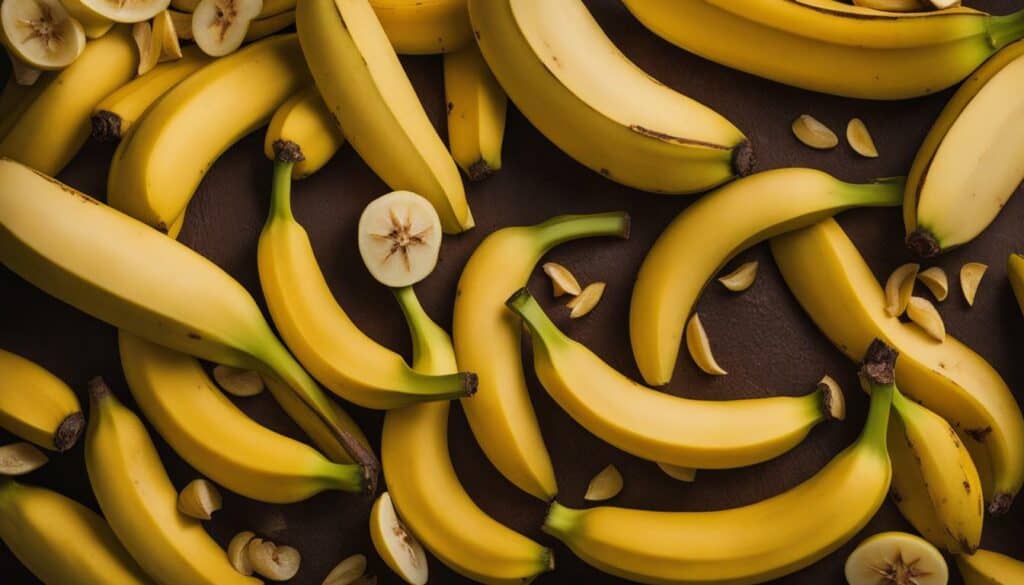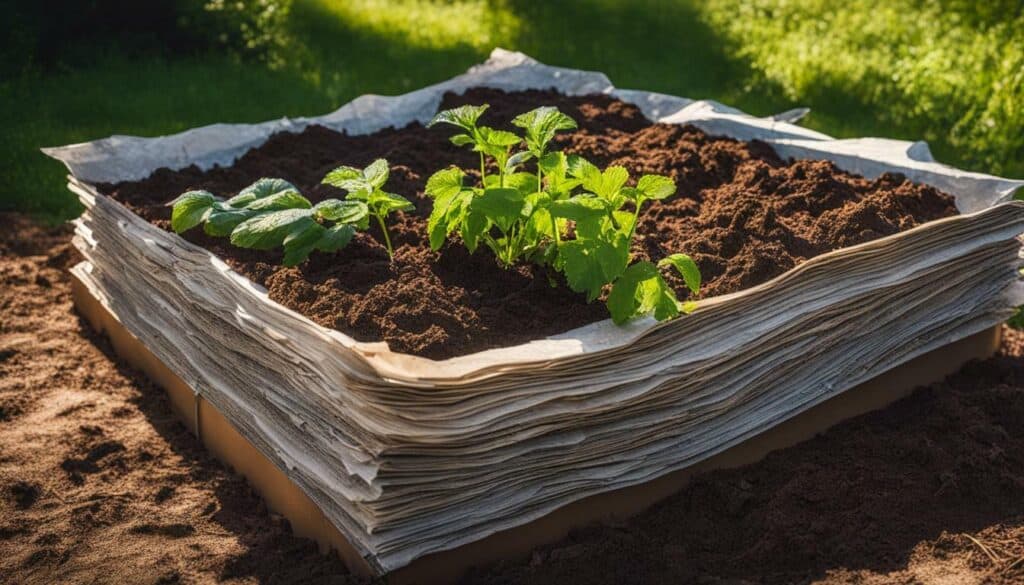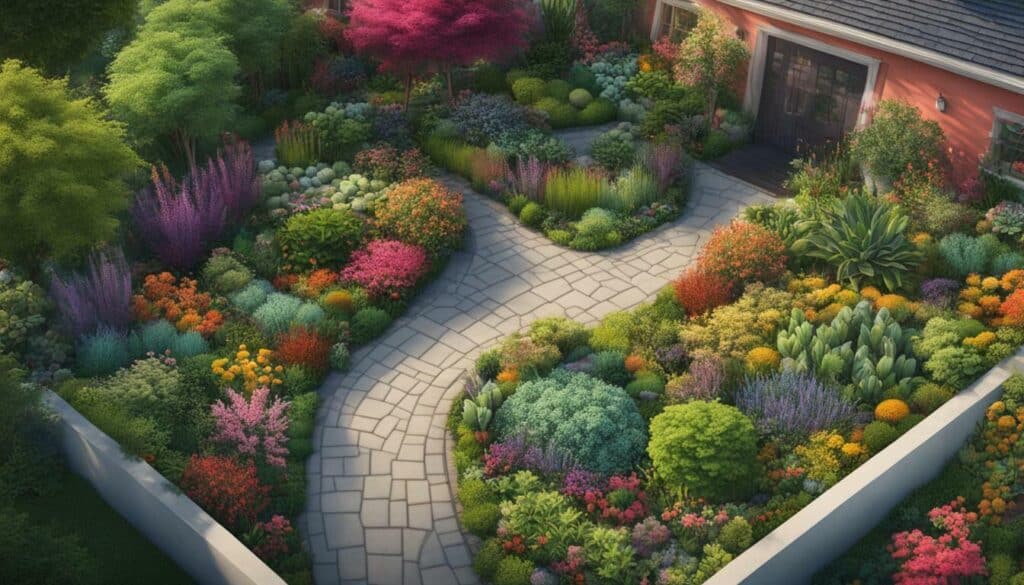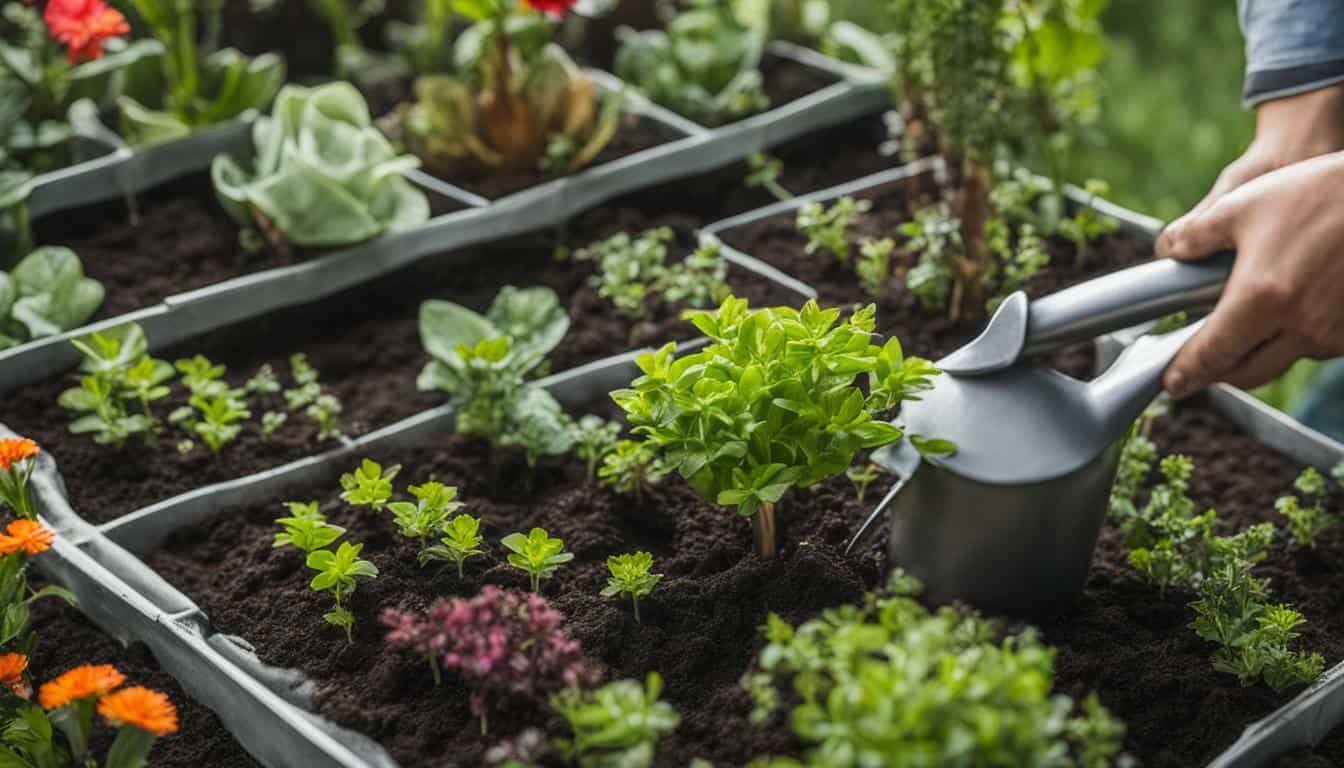Unlocking your green thumb and becoming a successful gardener doesn’t have to be difficult. With a few essential tips, you can thrive in your gardening endeavors. Whether you’re a seasoned gardener or just starting out, these tips for gardening advice will help you grow lush plants and bountiful harvests.
Key Takeaways:
- With essential tips, anyone can develop a green thumb and enjoy gardening success.
- Planning, starting small, and maintaining your garden are essential for success.
- Using natural ingredients like banana peels, green tea, and black pepper can help with soil nutrition and pest control.
- Techniques like lasagna gardening can be used to control weed growth without digging.
- Milkweed can be used to attract beneficial insects like monarch butterflies.
Create Nutrient-Packed Drinks with Banana Peels
One of the most surprising yet effective gardening tips is to use banana peels to create a nutrient-packed drink for your plants. Don’t throw away those peels just yet – they contain essential nutrients that promote plant growth.
Potassium, magnesium, and calcium are just some of the nutrients found in banana peels that benefit plants. Potassium, for instance, helps defend against diseases and insects, while magnesium aids in photosynthesis, and calcium helps oxygenate the soil.
To make banana peel water, cut the peel into small pieces, and drop them into a sealed container filled with water. Let the mixture sit for three days, shaking it daily. After three days, strain the liquid and pour it into the soil or use it as a spray.
This nutrient-packed drink is ideal for plants like roses, succulents, tomatoes, and orchids that thrive on nutrient-rich soil. Using banana peels to fertilize plants is an effective and inexpensive way to promote their growth and keep them healthy.

Eliminate Moss with Diluted Bleach or Liquid Lime
Dealing with moss in your garden can be a hassle, but there are simple solutions to eliminate it effectively. Moss can invade stone garden barriers, statues, and water features, but using bleach can help remove it. To make a bleach solution, dilute about 20 ounces of bleach in 5 gallons of water and spray it on the moss in the affected areas. Let it sit for a few hours before sweeping it away.
However, be cautious when using bleach near your garden, as it can harm plants. Instead, you can opt for a safer alternative like liquid lime. Moss is more likely to grow in moist, cool areas, especially when the pH is on the lower side. Using liquid lime can help eliminate it by altering the pH level. Simply apply the liquid using a sprayer or watering can to the affected area.
When using either solution, be sure to wear gloves, protective clothing, and goggles to protect yourself from the chemicals.

Eliminating moss is crucial for maintaining a healthy and visually appealing garden. With the right tools and techniques, you can remove it effectively and prevent it from coming back.
Attract Monarch Butterflies with Milkweed
Enhance your garden and support the habitat of monarch butterflies and other beneficial insects by planting milkweed. Milkweed is a plant that is easy to grow and provides food and nectar for monarch butterflies. It is a versatile plant that thrives in different soil types and climates, making it an excellent addition to any garden.
Aside from being a favorite of monarch butterflies, milkweed is also a natural pest repellent. It attracts other beneficial insects such as bumblebees and ladybugs, which help maintain the balance of nature in your garden. By planting milkweed, you create a haven for monarch butterflies and contribute to the overall health of ecosystems.
When planting milkweed, keep in mind that it is a drought-tolerant plant that requires minimal water. It is also a low-maintenance plant that does not require fertilizers or pesticides. Milkweed can be grown from seed or propagated from cuttings. It is essential to plant milkweed in areas where it is not easily disturbed or eaten by pests.

By incorporating milkweed into your garden, you can help conserve the habitat of monarch butterflies and other beneficial insects while beautifying your outdoor space. Add milkweed to your garden today and watch as your garden becomes a thriving ecosystem.
Try Lasagna Gardening for Easy Weed Control
Say goodbye to back-breaking weeding by trying out the innovative technique of lasagna gardening. This method involves layering cardboard or newspaper on the ground, followed by soil and other organic materials. The layers of cardboard or newspaper smother existing weeds and prevent new ones from growing. This technique eliminates the need for digging deep into the ground and pulling out weeds, making it a convenient and effective way to maintain a garden.
Lasagna gardening is especially beneficial for plants with shallow root systems, such as daylilies and irises. By following this method, gardeners can save time and effort in weed control and focus on other aspects of garden care. This technique is simple and can be implemented by anyone, whether they have a green thumb or not.
Overall, trying lasagna gardening can be an excellent option for those looking for an easy and efficient way to control weeds in their gardens. By utilizing this method, gardeners can enjoy a weed-free garden and spend more time enjoying the fruits of their labor.

Implementing the lasagna gardening technique involves layering organic materials such as leaves, grass clippings, and compost between cardboard or newspaper layers. Over time, the cardboard and newspaper break down and become part of the soil, enriching it with nutrients. This approach also helps to retain moisture in the soil, preventing it from drying out too quickly.
Use Green Tea as a Natural Fertilizer for Raspberry Bushes
Don’t throw away your used green tea leaves – they can be a fantastic natural fertilizer for your raspberry bushes. Green tea leaves contain valuable nutrients such as potassium and phosphorus that can benefit your plants. Instead of buying costly fertilizers, repurpose your tea leaves to provide the necessary nutrients your raspberry bushes need.
To use green tea as fertilizer, save the loose leaves or cut open a tea bag, then work the leaves into the soil around the base of your raspberry plants. The leaves will slowly release their nutrients into the soil, promoting the growth of your bushes. Additionally, raspberry plants thrive in acidic environments, and the tannic acid in green tea contributes to the acidic pH that the bushes love.
This natural fertilizer hack is not only cost-effective but also promotes sustainability by reducing waste. Not to mention, it’s an easy way to give your raspberry bushes the nutrients they need to produce healthy and delicious berries.

So, the next time you enjoy a cup of green tea, remember to save the used leaves for your garden. Your raspberry bushes will thank you for the nutrient boost, and you’ll be contributing to a healthier and more sustainable lifestyle.
Harness the Power of Black Pepper as a Natural Pest Repellent
Keep your garden free from unwanted pests and diseases by harnessing the power of black pepper. This natural pesticide is a useful tool for gardeners looking for an environmentally friendly way to protect their plants.
Black pepper contains piperine, capsaicin, and piperylene, which repel animals and kill insects. These compounds also have antibacterial properties, making black pepper a powerful ally in the fight against plant diseases.
To use black pepper as a pesticide, sprinkle it directly into the soil near the plant roots. Alternatively, you can create a black pepper spray by combining 1 teaspoon of black pepper with water and spraying it on the affected areas.
| Black Pepper Pesticide Recipe | ||
|---|---|---|
| Ingredients: | 1 teaspoon black pepper | 1 cup water |
| Instructions: | Dissolve black pepper in water. | Transfer to a spray bottle and spritz affected areas. |
This natural pest repellent can help protect your garden from pests and reduce the spread of plant diseases. Plus, it’s a cost-effective solution that won’t harm the environment. So, give black pepper a try and see the results for yourself!

Plan, Start Small, and Maintain Your Garden
Starting a garden requires careful planning, starting small, and consistent maintenance. One of the most important steps is to decide which plants you want to grow. Consider two to three fruits, vegetables, or herbs that you enjoy eating and focus on those. This way, you can concentrate on these plants and give them the attention they need.
Before buying new supplies, think about what you already have on hand. Many items, such as plastic jars and bottles, can serve as seedling trays, and seeds can be saved from store-bought produce, reducing costs and waste.
Designing your garden layout is crucial, so think about the space, soil, sunlight, and water requirements of your plants. A well-designed garden ensures that each plant receives the necessary resources and minimizes overcrowding and competition for resources among plants. To learn from the experiences of other gardeners, consider joining a gardening club or seeking advice from experts in your area.
Maintaining your garden requires regular watering, weeding, pruning, and fertilizing. Adequate watering ensures that the plants receive sufficient moisture to grow, while weeding reduces competition from other plants for water and soil nutrients, reducing the likelihood of garden diseases. Pruning facilitates optimal growth and ensures that the plants receive enough sunlight, while fertilization ensures that the plants receive necessary nutrients, promoting growth and production.
Finally, harvest your produce when it’s ready and enjoy the satisfaction of your hard work. Incorporate your home-grown produce into your meals for a healthier and more sustainable lifestyle. By following these tips, you can plan, start small, and maintain a successful garden.

Conclusion: Unlock Your Green Thumb Today!
By incorporating these essential gardening tips, you can unlock your green thumb and experience the joy of successful gardening. Planning your garden layout and selecting the right plants for your space and climate are crucial for success. If you’re just starting out, choose plants you enjoy eating to keep yourself motivated.
Remember to maintain your garden by regularly watering, weeding, and pruning your plants. Fertilizing your plants and harvesting them at the appropriate time can also help them grow and stay productive.
If you’re feeling unsure or need extra support, consider seeking advice from local experts, joining a gardening club, or volunteering with a gardening charity.
Cultivating a green thumb requires curiosity, creativity, planning, and patience, but the rewards are numerous. With these qualities and a little effort, you can experience the beauty and satisfaction of gardening at home.
FAQ
Q: What plants benefit from using banana peels as a nutrient-packed drink?
A: Roses, succulents, tomatoes, and orchids particularly benefit from this concoction.
Q: How can I eliminate moss in my garden?
A: You can eliminate moss using diluted bleach or liquid lime. Spray the moss with the solution, let it sit for a few hours, and then sweep it away. Be careful not to use bleach near other plants.
Q: What are the benefits of planting milkweed in my garden?
A: Milkweed attracts monarch butterflies and other beneficial insects. It is easy to grow, drought-tolerant, acts as a natural pest repellent, and improves soil quality.
Q: What is lasagna gardening and how does it reduce weed growth?
A: Lasagna gardening involves layering cardboard or newspaper with soil and organic matter. This method eliminates the need for digging and effectively reduces weed growth.
Q: How can I use green tea as a natural fertilizer for raspberry bushes?
A: Save the brewed leaves and work them into the soil around the base of the plants. You can also use steeped green tea water to water the plants.
Q: How can black pepper be used as a natural pest repellent?
A: Sprinkle black pepper around plant roots to get rid of insects and pests and protect your garden from diseases.
Q: What are some important tips for starting and maintaining a garden?
A: When starting your garden, plan and start small. Choose plants you enjoy eating, consider your garden’s layout and location, select nutrient-rich soil, and regularly water, weed, and fertilize your plants.
Q: What is the conclusion of these gardening tips?
A: By following these essential tips, you can unlock your green thumb and have a successful gardening experience.
Source Links
- https://www.housedigest.com/1306632/garden-hacks-instant-green-thumb/
- https://uyirorganic.farm/gardening-at-home/
- https://www.nextavenue.org/you-can-have-a-green-thumb/
- https://www.linkedin.com/posts/smrita-gupta-9a510832_green-thumb-secrets-revealed-boost-activity-7100545307901329409-TcbF
- https://medium.com/@matt-croak-plants/nutrient-packed-banana-water-for-your-plants-bebe4be998ba
- https://sustainableholly.com/dried-banana-peel-fertilizer/
- https://www.gardenmyths.com/banana-peels-garden/
- https://www.express.co.uk/life-style/garden/1600601/gardening-tips-hacks-how-to-remove-moss-pavements-bleach
- https://www.housedigest.com/1200252/the-gardening-hack-that-will-remove-moss/
- https://www.joeslawncare.co.uk/treatments/how-to-turn-your-fairy-liquid-into-an-epic-moss-killer/
- https://monarchbutterflygarden.net/how-to-start-monarch-butterfly-garden/
- https://www.saveourmonarchs.org/blog/eco-friendly-ways-to-attract-monarch-butterflies-to-your-garden
- https://www.gardeners.com/how-to/monarch-waystation/8603.html
- https://getbusygardening.com/lasagna-gardening/
- https://www.thespruce.com/how-to-make-a-lasagna-garden-2539877
- https://miraclegro.com/en-us/projects-planning/lasagna-gardening-101.html
- https://www.vegetable-gardening-online.com/growing-red-raspberries.html
- https://senbirdtea.com/3-ways-to-use-green-tea-leaves-in-your-garden/
- https://www.homesandgardens.com/advice/using-tea-leaves-in-the-garden
- https://www.housedigest.com/1290377/black-pepper-works-pesticide-garden-soil/
- https://flourishingplants.com/using-black-pepper-on-plants/
- https://farmhomestead.com/black-pepper-pesticide/
- https://www.almanac.com/vegetable-gardening-for-beginners
- https://www.bhg.com/gardening/yard/garden-care/ten-steps-to-beginning-a-garden/
- https://www.thespruce.com/how-to-start-a-garden-from-scratch-2132778
- https://portfarms.com/finding-your-green-thumb/
- https://evashockey.com/gardeninghacksgreenthumb/
- https://www.finegardening.com/article/community-gardening-sharing-your-green-thumb-passion






Leave a Reply